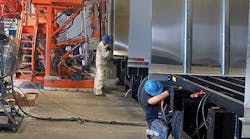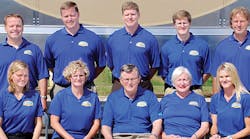DON Wahlin was blunt. Had the company that he founded 53 years ago not completed a prolonged estate planning process, it would not have been able to survive the loss of its founder.
Estate taxes can be landmines for family businesses. Because so much of their value is tied up in non-liquid assets, it’s not unusual for family businesses to be forced to sell key assets to pay estate tax liabilities—at precisely the time that they have lost the individual who had started and grown the business.
Of course, killing the family business is not the goal of the tax code, and provisions are in place that can enable companies to reduce those liabilities.
“It has taken 14 years to transfer ownership of the company to a family limited partnership,” Wahlin says. “Without that, the company would have failed when estate tax was due.”
Instead, one of North America’s largest trailer manufacturers is positioned to remain in the family for years to come.
Stoughton Trailers has been part of the Wahlin family for more than half a century. Don Wahlin went business for himself by purchasing the assets of his former employer, Stoughton Cab & Body. He initially named his new acquisition Stoughton Truck Body.
Fifty-three years later, he continues to be involved in what is now Stoughton Holdings, along with its flagship company, Stoughton Trailers. But the day-to-day operation of the family business is now in the hands of the second generation.
“Maintaining a business is a completely different job from starting one,” Bill Wahlin says. “Don has been very successful starting Stoughton Trailers and building this business. Now it’s our turn to take what he has built and grow it.”
While Congress has written provisions into the tax code that can help family businesses transition to the next generation, when it comes to preparing the next generation to run it, that’s entirely up to you.
The Wahlin family started early. Don and Carol Wahlin’s children, as Don says, have been working at the company since they were about seven years old.
“It has been great to be see this transition without inserting myself into it,” Don Wahlin says.
Each of the siblings has developed areas of specialization. Bob Wahlin is president of Stoughton Trailers. Ken, with degrees in law and engineering, heads up the holding company under which the other companies operate. Bill Wahlin specializes in Stoughton’s engineering operations. Kate Wahlin Schieldt serves as vice-president of human resources, and Dan Wahlin is the company’s assistant controller. Margaret Wahlin Blanchard and Mike Wahlin, board member are board members, while Betsy Wahlin McClimon, directs the Wahlin Foundation.
“We have put each of them into positions that are best suited for their talents and personalities,” Don says.
Making changes
Now that the company’s legal structure and the second generation are in place, what’s next? Neither generation is content to let Stoughton rest on its laurels. Recent changes include:
• Acquiring Barrett Trailers LLC in Purcell, Oklahoma, a manufacturer of gooseneck stock trailers, groundload livestock trailers, and semi livestock trailers.
• New product offerings and improvements to existing products.
• Manufacturing plant refinements, including the purchase of several new pieces of fabricating equipment.
With one move this summer, Stoughton expanded its reach geographically while increasing capacity and adding depth to its product line.
STI Holdings, the parent company of Stoughton Trailers acquired Barrett Trailers, LLC of Purcell, Oklahoma. Barrett manufactures gooseneck stock trailers, groundload livestock trailers, and semi livestock trailers. The company’s primary market is hogs and cattle transportation.
The Barrett product line should complement Stoughton’s grain trailer offerings, but the acquisition also provides other advantages.
“The location is appealing to us because it puts us much closer to the Southwest United States,” says Scott Nachreiner, Stoughton’s marketing manager. “It’s an opportunity for us to expand and yet stay close to our core competencies.”
Stoughton is in the process of upgrading the Barrett plant.
“We believe their plant is capable of producing more trailers than they currently are building—especially 53-foot models,” Nachreiner says.
New products and orders
Stoughton has developed a number of new products and refinements recently, including a high-based rail option for the Stoughton plate trailer. This option adds strength to the trailer and eliminates the need for scuff liner.
“We have had this available for some time now, but we recently changed our manufacturing process and reengineered it to make it more price competitive.
With liquid deicing becoming commonplace, fleets are increasingly concerned about corrosion. Stoughton is offering more extensive use of galvanized steel.
“Demand for galvanizing is growing. So is the use of stainless steel.”
Stoughton is working on a major order for United Parcel Service that is scheduled to be completed in November. Stoughton is dedicating a separate line to produce the UPS order. The remainder of its fleet business is being produced on other high-speed lines.
New ways to build them
The company recently expanded its staff of manufacturing engineers to increase the company’s ability to develop new ways to continuously improve the way Stoughton builds trailers.
“We believe in vertical integration,” Bill Wahlin says. “We want to product as much of the content that goes into our trailers as possible. By doing so, we control the quality of the part as well as its availability.”
To make that happen, Stoughton dedicates one entire plant on its campus for fabrication. That plant feeds fabricated parts to the other manufacturing facilities in Stoughton, Broadhead, and Evansville, Wisconsin.
Most of the company’s manufacturing facilities are on its main campus in Stoughton—buildings that the company added over the course of its 53 years in business. The hometown plants include one dedicated to hopper trailers, one that features two assembly lines that can be configured to meet the changing demand for specific types of trailers, and another for research and development.
Stoughton’s plant in nearby Broadhead, Wisconsin, is set up for high-speed production of large orders of dry-freight van trailers. About 20 miles from Stoughton is the company’s intermodal plant, home of container chassis and domestic container production.
New manufacturing equipment
Stoughton has invested in new manufacturing technology recently, including:
• Automatic drilling machines improve productivity and quality. They require that crossmembers are perfectly straight, but they enable floors to be drilled and screws driven in one efficient process.
• Robotic welding. Robots now weld the rear frame and upper coupler assemblies of standard Stoughton trailers.
• New torque equipment to ensure that torque is applied consistently and accurately.
• A new laser with automated material handling system.
“The laser can cut holes—we don’t need punch them. Plasma--even a high-definition plasma—does not produce a square edge,” Bill Wahlin says. “It tends to cut a cone-shaped hole, and that isn’t good enough if you are going to put a bolt in that hole. Accuracy in fabrication is essential if assembly is to go smoothly.”
The company’s Broadhead and Stoughton plants have been outfitted with new equipment designed to make them more productive and ergonomic. They include equipment for applying torque to spindle nuts and metering equipment for lubricating wheel ends.
New roofing systems are now in place. Stoughton stretches its roof sheet in two directions. The company tensions the sheet longitudinally as is common practice. However, Stoughton also applies tension transversely through the use of what the company calls an “infinity” beam. The beam depresses the roof bows until the roof sheet can be secured. When the beam is removed, the bows arc upward to apply transvers tension to the sheet.
“Ultimately, it’s all about quality,” Bill Wahlin says. “We are constantly revamping our production lines to meet the requirements of the products we are building. Given the variety of specifications we offer, we have to have production lines that are flexible.”
One example is the company’s sidewall assembly machines, known within Stoughton as SAMs. They are capable of producing the sidewalls of either plate trailers or conventional sheet-and-post vans.
“We developed these machines about five years ago. They do a great job, and we are constantly seeking ways to make them more productive.”
The changes at Stoughton are part of doing business in the trailer industry today.
“Everyone is great at what they do now,” Don Wahlin says. “There are smarter people running things. People are more sophisticated. Quality is good throughout the industry. Our challenge at Stoughton is to build a high-quality trailer as efficiently as possible.”
The second generation agrees.
“Our business requires that we find better, less costly ways of doing things,” Bill Wahlin says. ♦










